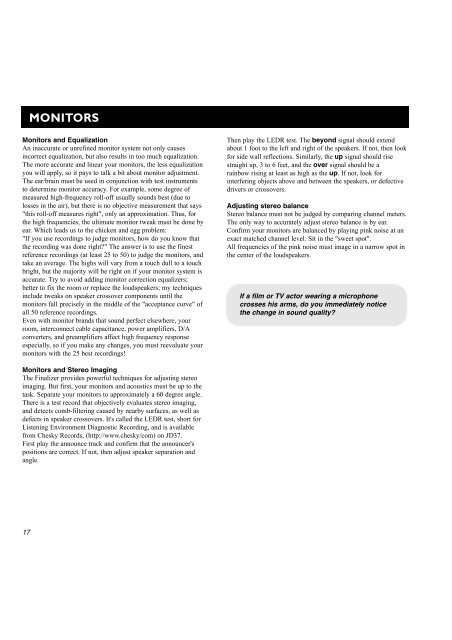2x4cdyD3b
2x4cdyD3b
2x4cdyD3b
You also want an ePaper? Increase the reach of your titles
YUMPU automatically turns print PDFs into web optimized ePapers that Google loves.
MONITORS<br />
Monitors and Equalization<br />
An inaccurate or unrefined monitor system not only causes<br />
incorrect equalization, but also results in too much equalization.<br />
The more accurate and linear your monitors, the less equalization<br />
you will apply, so it pays to talk a bit about monitor adjustment.<br />
The ear/brain must be used in conjunction with test instruments<br />
to determine monitor accuracy. For example, some degree of<br />
measured high-frequency roll-off usually sounds best (due to<br />
losses in the air), but there is no objective measurement that says<br />
"this roll-off measures right", only an approximation. Thus, for<br />
the high frequencies, the ultimate monitor tweak must be done by<br />
ear. Which leads us to the chicken and egg problem:<br />
"If you use recordings to judge monitors, how do you know that<br />
the recording was done right?" The answer is to use the finest<br />
reference recordings (at least 25 to 50) to judge the monitors, and<br />
take an average. The highs will vary from a touch dull to a touch<br />
bright, but the majority will be right on if your monitor system is<br />
accurate. Try to avoid adding monitor correction equalizers;<br />
better to fix the room or replace the loudspeakers; my techniques<br />
include tweaks on speaker crossover components until the<br />
monitors fall precisely in the middle of the "acceptance curve" of<br />
all 50 reference recordings.<br />
Even with monitor brands that sound perfect elsewhere, your<br />
room, interconnect cable capacitance, power amplifiers, D/A<br />
converters, and preamplifiers affect high frequency response<br />
especially, so if you make any changes, you must reevaluate your<br />
monitors with the 25 best recordings!<br />
Then play the LEDR test. The beyond signal should extend<br />
about 1 foot to the left and right of the speakers. If not, then look<br />
for side wall reflections. Similarly, the up signal should rise<br />
straight up, 3 to 6 feet, and the over signal should be a<br />
rainbow rising at least as high as the up. If not, look for<br />
interfering objects above and between the speakers, or defective<br />
drivers or crossovers.<br />
Adjusting stereo balance<br />
Stereo balance must not be judged by comparing channel meters.<br />
The only way to accurately adjust stereo balance is by ear.<br />
Confirm your monitors are balanced by playing pink noise at an<br />
exact matched channel level. Sit in the "sweet spot".<br />
All frequencies of the pink noise must image in a narrow spot in<br />
the center of the loudspeakers.<br />
If a film or TV actor wearing a microphone<br />
crosses his arms, do you immediately notice<br />
the change in sound quality?<br />
Monitors and Stereo Imaging<br />
The Finalizer provides powerful techniques for adjusting stereo<br />
imaging. But first, your monitors and acoustics must be up to the<br />
task. Separate your monitors to approximately a 60 degree angle.<br />
There is a test record that objectively evaluates stereo imaging,<br />
and detects comb-filtering caused by nearby surfaces, as well as<br />
defects in speaker crossovers. It's called the LEDR test, short for<br />
Listening Environment Diagnostic Recording, and is available<br />
from Chesky Records, (http://www.chesky/com) on JD37.<br />
First play the announce track and confirm that the announcer's<br />
positions are correct. If not, then adjust speaker separation and<br />
angle.<br />
17


